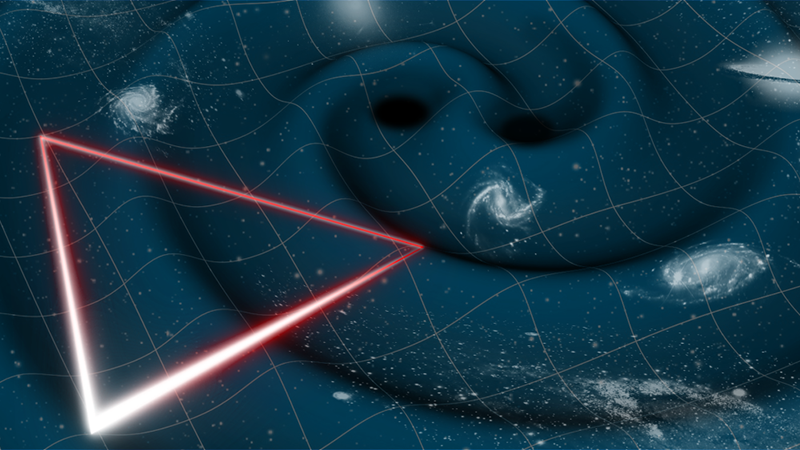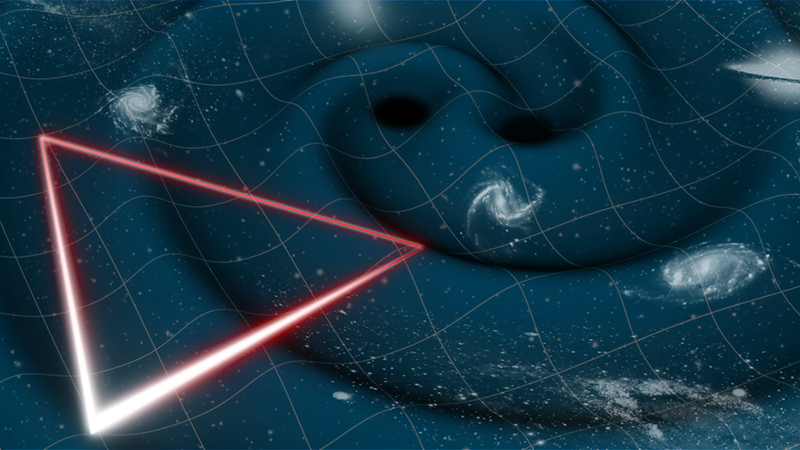Gravitational-Wave Memory May Illustrate Spacetime Symmetries
Gravitational waves stretch and shrink the fabric of spacetime itself. But they also have a lesser-known (and lesser-understood) property. After their passage, they leave a permanent mark on the Universe, forever changing the distances between two points in space. This effect, called gravitational memory, is predicted in general relativity to be very small, but it could potentially be isolated in future gravitational-wave detectors, such as the spaceborne Laser Interferometer Space Antenna (LISA). A new theoretical study by Boris Goncharov from the Max Planck Institute for Gravitational Physics (Albert Einstein Institute) in Germany and colleagues explores what we might learn about spacetime symmetries of the Universe from the detection of gravitational memory [1]. The results suggest that memory observations may offer insights into how general relativity can be unified with quantum theory.
Gravitational waves are created in powerful cataclysmic events such as explosions of supernova, the merger of black holes, and even the birth of the Universe itself. When a gravitational wave passes by two objects—say, two mirrors in a gravitational-wave detector—it causes oscillations in the distance between the objects. According to general relativity, the spacetime strain caused by the wave is a form of localized energy, similar to a massive object. As such, the wave will curve spacetime, like a bowling ball sitting on a mattress. This curving produces another generation of gravitational waves, which further curves spacetime. The process repeats, creating generation after generation of gravitational waves that together cause a change in the distance between the two points in space, which remains long after the oscillations of the gravitational wave have died down. This form of gravitational memory, called displacement memory, was first predicted 50 years ago [2].
In 2016, physicists uncovered a second type of gravitational memory, called spin memory, which is an imprint of the angular momentum of the sources of gravitational waves [3]. This gravitational “twisting” has a permanent effect on the rotational motion of objects. Both spin and displacement memories can cause detectable changes in the strain amplitude of a wave’s oscillations, but the effects are predicted to be small. “Displacement memory’s strain amplitude is roughly 10% of a gravitational-wave signal’s strain amplitude,” says Goncharov. And spin memory effects are expected to be much smaller than those of displacement memory. Current gravitational-wave observatories have not been sensitive enough to detect either effect.
Future observatories might have better luck. Goncharov and his colleagues consider the prospects of detecting gravitational memory in LISA as well as the Einstein Telescope and the Cosmic Explorer (both future ground-based detectors). Unlike previous work that investigated potential memory signals, the researchers explore how a memory detection might reveal information about symmetries that are built into the spacetime fabric of our Universe. These so-called asymptotic symmetries concern geometric operations (like translations and rotations) that are performed at large distances—far away from any galaxies or other masses—where gravity goes to zero. There are different models for what these symmetries look like and how many of them are present.
Goncharov and his colleagues look at the effect that these different symmetry models might have on potential memory observations. “Different symmetry models produce different forms of memory by allowing different deformations of the spacetime at large distances,” says Goncharov. One model, for example, generates displacement memory but not spin memory, while another produces both effects.
The researchers simulate gravitational-wave signals in various scenarios. Their results suggest that LISA could potentially discriminate between different symmetry models in merger events between supermassive black holes. The Einstein Telescope and the Cosmic Explorer may have a harder time seeing memory effects from individual events but could provide information from cumulative observations.
If gravitational-wave detectors can isolate memory effects and, furthermore, see signatures of a particular symmetry model, then researchers might be able to learn something about quantum field theory. The reason has to do with the “infrared triangle,” a theoretical construct that connects three areas in fundamental physics: memory effects, spacetime symmetries, and so-called soft theorems that describe low-energy scattering behavior in quantum physics. Illuminating one corner of the triangle can lead to insights about the other corners. “This may be a path toward a unification of gravity and quantum theory, which is a missing cornerstone in modern physics,” says Goncharov.
“I think it’s extremely worthwhile to try to [predict memory effects] from an observational point of view,” says Paul Lasky, an astrophysicist at Monash University, Australia, who was not involved in the study. But he points out that most researchers expect that memory signals will include both displacement and spin contributions. If future detectors see a deviation from those expectations, he’s not sure what that would mean for general relativity and quantum field theory. “I don’t think there’s currently a clear understanding of how to interpret an observation that doesn’t agree with expectations. But I guess that this is what makes all of this really fun and interesting!” he says.
–Elizabeth Fernandez
Elizabeth Fernandez is a freelance science writer based in Raleigh, North Carolina.
References
- B. Goncharov et al., “Inferring fundamental spacetime symmetries with gravitational-wave memory: From LISA to the Einstein Telescope,” Phys. Rev. Lett. 132, 241401 (2024).
- Ya. B. Zel’dovich and A. G. Polnarev, “Radiation of gravitational waves by a cluster of superdense stars,” Sov. Astron. 18, 17 (1974).
- S. Pasterski et al., “New gravitational memories,” J. High Energ. Phys. 2016, 53 (2016).





